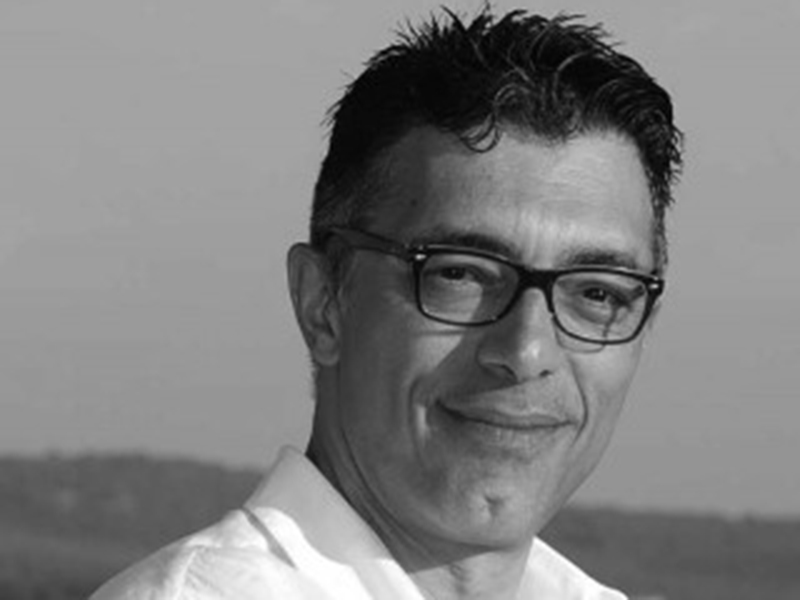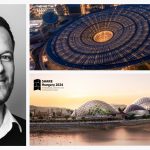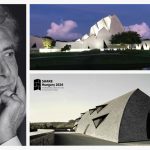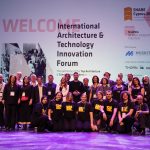In dialogue with KAMRAN AFSHAR NADERI for share-architects.com
In June 2018 at SHARE Sofia we met Kamran Afshar Naderi – a well-known Iranian architect, architectural critic, painter and artist, founder of Memar magazine and a regularly jury member of Memar Award. Our captivating talk on the topic of the editorial project, “Designing the Profile of The Future Architect” has turned into an exciting discussion about his life, his work, career and the state of architecture in Iran.
Andreea Robu-Movila, publisher share-architects.com: In the first instance please offer us an insight into the life and work of the artist, theoretician and architect Kamran Afshar Naderi.
Kamran Afshar Naderi: As an architect I do several things and of course, a big part of my life is dedicated to architecture; but I do architecture as a hobby. This means that my revenue isn’t coming from designing, but from other side activities related to construction.
Andreea Robu-Movila, publisher share-architects.com: That is interesting!
K.A.N: I needed to have some freedom to do what I do, and I realized several years ago that it would be very difficult for me to live just by being a professional architect. So I started to select a few projects and then I dedicate as much time as needed, without looking if I’m running out of budget.
A.R.M: But how do you live?
K.A.N: First of all, I work quite a lot [laugh]. I have several things that are related to each other. I am the Branch Manager of an international engineering company, so my work consists of marketing, management, these things… And this is… my job. Around twenty years ago I founded an architecture magazine, which is now the most popular and influential architecture magazine around (MEMAR Magazine) So this is another revenue source, being co-founder and partner of this magazine. I write articles, I organize competitions and I chaired tens of competitions and awards. Then, I have my own office, I am doing some projects as I told you; I’m doing some artworks as well; I am now working on creating quite a big artwork for a cultural center in Lyon, France – the French Centre for Islamic Civilizations. Then around seventeen years ago, I co-founded an award for architecture. I also teach at the university, so, as you see, I’m doing a lot of things.
A.R.M: Memar Award?
K.A.N: Yes, Memar Award.
A.R.M: Is it adressed only to Iranian architects?
K.A.N: Yes, it is dedicated to the Iranian architects, but sometimes I’m involved in international competitions as well: I am assisting our national gas company in organizing an international competition for designing its headquarters, which is a huge project – many people from around the world are taking part in this competition.
A.R.M: In this convoluted profile just describe, do you believe that the portrait of an architect should be so complex?
K.A.N: When I started my first architecture class I had a professor who used to teach us architecture as a part of a very vast knowledge base. During his lectures, he used to sing, play music, draw, design and even perform theatrically. I think that architecture is part of a very large domain that embodies different types of knowledge. I apply this in my life – I think that the work of an architect doesn’t just start at 9 o’clock when he goes to the office, he needs to live as an architect. You know, architecture is multidisciplinary by nature and also by the way of practicing it. I teach Design Process and Theories at the university; instead of teaching a specific method, I educate my students to have a creative and proactive reaction towards the society and environment. Creativity is an innate capacity of human beings and you can train yourself to use it on a regular base. Many years ago, I was accompanying the famous designer Ettore Sottsass to the residence of the Italian Ambassador in Tehran. Instead of bringing the usual flower bouquet arranged by the nearest florist, he preferred a bunch of fragrant tuberose flowers carried in his arms. No paper, ribbon or decoration. This was a very simple but at the same time creative gift by a creative person. I explain the students that creativity is a natural attitude of humans towards every aspect of everyday life and when it becomes a profession, the process is very similar to the fields of arts and sciences. Everything I teach is about being able to have a creative reaction to what happens around, even by leaving a meaningful post on Facebook.
Machines and animals can do perfectly the tasks they already know. Humans can do things that they don’t know and this is the quality that fascinates me. I’m always trying to stretch the limits of myself by trying new tasks. I don’t think I am talented as an artist – but I am producing artworks that have some qualities. I dedicate a lot of time to identify my weaknesses and to overcome them. The same happened with writing. At school, in Tehran, I was one of the worst students in essay writing. When I was a university student, it took a huge effort for me to write my first article which appeared in a book about the public spaces in Italy in 1987. Gradually I gained some confidence and even after coming back to my country in 1993, I continued writing and publishing articles in several countries. I make it clear with a couple of examples. Some of my colleagues are good in designing an entire project by themselves. I am an architecture critic, so I need to keep sufficient distance from the project. I give the basic guidelines to my collaborators and then check and revise several times what they do. They have certain freedom in their work. In order to produce a big scale artwork, you need to have ideas, manual skill and engineering knowledge. I am neither artisan nor engineer. So I work with other experts and each one contributes to the art work as I do.
A.R.M: So you put a spot on that vulnerability and tried to turn it into a strength.
K.A.N: Yes, I believe an experienced architect shall keep the curiosity and impudence of a young beginner. I dedicated my life to study and to do as much as possible. At the end surprisingly I found everything connected to each other and parts of the big picture. My graduate thesis was about the design (conception) process in Iranian architecture during 11th to 17th centuries. For doing this, in addition to study the ancient buildings, I had to acquire the same knowledge of the architects during that period of time. I studied for 4 years, medieval mathematics, geometry, algebra, alchemy, astrology, magic, metrology and mechanics. Researches brought me to make a small, but interesting, discovery in history of structural mechanics (see Introduction to the History of Structural Mechanics, by Eduardo Benvenuto. Springer Verlag Gmbh, 1991).
A.R.M: What about your magazine?
Now it is 20 years old. When we started, in Iran, there were only two minor black and white architectural magazines and now there are tens. In addition to journalism, we published books, held seminars, organized events, established an award and created a large network of architects, students and professors. My recent project is to publish one of the most reputable international design and architecture magazines in Iran. I have two partners and we have already published the mockup issue.
A.R.M: Why do you write?
K.A.N: I always did what I had the possibility to do. I started to write because it was the only way of expressing myself as a foreign student in Italy and I published my first book when I was still a student (Le istituzioni collettive nelle citta’ islamiche, genoa, 1987). In that time, I used to work as a drafter in a company but it was quite frustrating.
A.R.M: It is about perseverance.
K.A.M: Yes. Writing remained for me a way to communicate. Sometimes, I prefer to write instead of talking to people.
A.R.M: Architecture can be perceived as a language in itself after all.
K.A.N: It should be a language. I think hopefully the things are changing. Architecture remained for a long time confined within the limits of visual perception and meaningless forms. In Iran, the architecture language used to be very close to the spoken language. Contrarily to the western civilizations, we accepted the language as the dominant media for transferring any kind of idea. For instance, when, during XVI-XIX century, the European voyagers came to Iran, they produced a great amount of illustrations showing people, monuments, nature and so on. Contrarily, our travelers left only written descriptions about what they had seen during their travels to Western or Eastern countries. Another example: even today in Iran property deeds of the buildings don’t contain any drawing, everything is explained in words. Iranians created outstanding buildings without using drawings. The language was accurate enough to describe an entire building without the necessity of drawings. And architecture was organized such as narration. Narration was an efficient mean of communication and therefore instrument for conceiving architectural ideas.
A.R.M: Yes, the medium is also the message.
K.A.N: If your main tool is the spoken language, you do a different kind of architecture. For example, instead of a formal composition you will have a building which its form is related to a narration. I discovered that in the ancient complex of Persepolis there were close connections between the system of proportions and the iconological meaning of the ornaments. In recent practice of architecture, Habibeh Madjdabadi, has replaced the technical drawings with a set of oral instructions. In some cases, it works and the project becomes quite different. In my recent projects for the Roche company, I didn’t provide the client any kind of rendering, but with some drawings and a lot of description about the quality of the space and materials. Both Client and I are satisfied.
A.R.M: Yes, because probably when you present a full set of drawings there is no space left for debate and interpretation.
K.A.N: In fact, I am developing the project together with the client and this uncertainty that gradually becomes clear makes him happy.
A.R.M: Yes, it is all about engagement!
K.A.N: Engaging! So, I think that engaging the clients in the project, drawing with them and allowing to express themselves using the language that is familiar to them, gives them more satisfaction – the client is happy – and reduces the judgement the architect gets. When I don’t show the renderings that are too clearly defined anyway, the client’s imagination starts to work and he has the time to adapt, learn and appreciate the building. Spoken language can play a better role in conceiving and transferring ideas.
A.R.M: In this regard, what is your definition of architecture?
K.A.N: The only accurate one is what the people of every epoch call architecture. I believe in this although it might seem banal. However, I think architecture represents just one of the infinite paths for ideas to become material.
I really like to show in some conferences how creativity in different fields is similar. If I asked you to create a joke, you would use the same mechanism that an architect uses for designing a concept. The way of writing a poem or writing music is the same as doing architecture, only the techniques are different.
A.R.M: What do you think that distinguishes the architectural thinking from the way of thinking of other fields?
K.A.N: Well, I think that the main difference is that architecture is a complex field. You can say about a four-year-old kid that he’ll certainly become a musician or he has a talent for mathematics. You can never discover in kids a talent for architecture. Architecture needs time for maturation.
A.R.M: Therefore, in relation to the new paradigm of artificial intelligence what do you believe that defines the architectural intelligence?
K.A.N: Well, humans cannot create honeycombs better than the bees and the computers will never create houses better than the architects. Most of the things we do consist of problem solving. Many people believe that we dedicate 90% of our time to creativity, but that is not exact. We maybe dedicate 1% of our time to “architectural creativity”, everything else is dedicated to resolving practical, technical or theoretical problems. These tasks need also creativity, but in a different way.
A.R.M: That is very true.
K.A.N: If you need to throw a party and have ten people with no experience in organizing parties, one of which is an architect, then I’m sure he will organize it better. He’ll find a way; an architect is an expert in doing something which he’s not expert in. Doctors practice medicine, but architects often do things they do not know.
We can think outside the box; we are ready to think outside the box. I found myself in so many situations in which I came up with a solution for problems that were out of my competence. Even with cooking [laughs]. Try to tell me I’ll have thirty people coming over tonight, all the shops are closed and I need to prepare something with what I find at home. You will see I’ll manage to do it, I’ll come up with something because I am ready, I’m always ready to do this. This is architectural intelligence.
A.R.M: You have already written a lot of books and articles on Iranian architecture. How would you describe the state of architecture in your country?
K.A.N: I had my last conference in Kuala Lumpur and it was titled Forward and Rewind. I think the architects are moving between the two extremes. One is the blind belief in the international trends considered as the idea for future – where we need to get – and the other one which tries to go back in history, valorizing the local knowledge and circumstances as an opportunity to do works, useful for the country and interesting for the people belonging to different cultures.
A.R.M: Understanding beneath the wish of the client can reveal the hidden potential of a response of high quality?
K.A.N: Yes, I try to get to the deeper layer of understanding. For example, many clients ask architects for classical buildings and the good architects refuse. In some cases we don’t really need to build classical buildings. What makes classical buildings so successful and popular is partly due to their relation to nature, to the proportions and to the complexity that pleases our eyes. Neuroscience propose the exact degree of complexity suitable for human beings. People are not as flexible as architects might think. Our brain and body have not changed so much during the past 20 thousand years, but architecture did. In a specific cultural context, the constants that the architect has to deal with, are even more.
A.R.M: In this regard how can we remain relevant in these times of great changes is matter of depth consideration and a theme for further thinking.
It was an amazing talk, thank you for your time!



